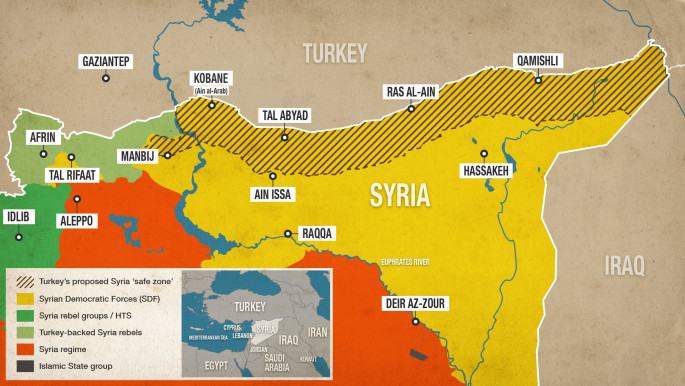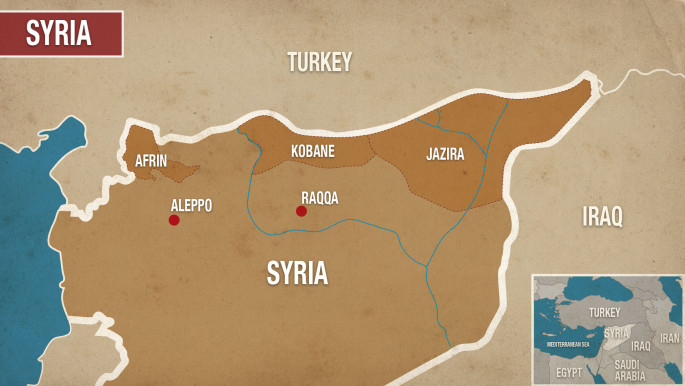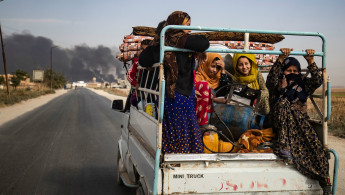Turkey, the Kurds and the demographic re-engineering of Syria
The recently launched Turkish operation against Kurdish militias in northeastern Syria brings with it fears of ethnic cleansing and demographic change. Turkey has said that "Operation Peace Spring" aims to set up a 30-kilometre wide "safe zone" in northeastern Syria, which would be under the control of Turkish-allied Syrian rebel groups. President Erdogan has said that Turkey aims to settle nearly three million of Syrian refugees in the safe zone.
Much of the area where Turkey plans to settle Syrian refugees has always had a Kurdish majority, particularly the areas of the Jazirah region to the northeast of al-Hasakeh, including the city of Qamishli. Other areas of northeastern Syria have a majority Arab population or a mixed Kurdish-Arab population.
When the Syrian uprising began in 2011, protests broke out in Kurdish-majority towns such as Qamishli, Amuda, and Derbassiya. The Kurds had even more reason than most Syrians to resent the Assad regime, but they were as divided in their ideology and aims as was the rest of the Syrian opposition.
In 2011, the Kurds formed roughly ten percent of the population of Syria. However, accurate information regarding their total population, or even which areas had a Kurdish population, was difficult to obtain. In line with its Baathist Arab nationalist ideology, the Assad regime did not recognise the existence of a Kurdish minority, suppressed the Kurdish language and any manifestation of Kurdish culture, and denied hundreds of thousands of Kurds Syrian citizenship.
In addition, there was a major dispute between the Syrian Arab opposition and the Kurdish opposition over the rights of Kurds in a post-Assad Syria, with Kurdish parties demanding federalism and Arab ones refusing to contemplate it.
Read more: The demise of Arab-Kurdish solidarity in Syria
However, one Kurdish party, the Democratic Union Party or PYD, managed to assert its dominance. Founded in 2003 as an underground opposition group, its links with the Kurdistan Workers' Party (PKK), which had fought a separatist insurgency against Turkey since 1984 helped it to establish governance structures in Kurdish-majority areas of Syria. Despite its suppression of Syrian Kurds, the Assad regime maintained close links with the PKK in the 1980s and 1990s, motivated by a hostility towards to Turkey.
 |
| Turkey aims to create a 'safe zone' in northern Syria |
In 2012, the Assad regime withdrew from most Kurdish-majority areas in northeastern Syria, preferring to focus its war on the Free Syrian Army and affiliated groups.
These areas were turned over, without a fight to the PYD and the Popular Protection Units (YPG) that it set up jointly with other Kurdish parties. Since then, an unwritten non-aggression pact between the regime and the PYD and YPG has prevailed and the Turkish operation against the YPG has now led to a new pact between them and the regime.
Utopia and authoritarianism
Following the withdrawal of the regime, the PYD set up a system of government, the Autonomous Administration of North and East Syria, also known as Rojava, which on paper seemed unique and utopian.
It was based on the theories of the anarchist-communist American philosopher, Michael Bookchin. Centralised rule would be abandoned and power would be handed over to local communes (kominat). Founded as a Kurdish party, the PYD officially abandoned Kurdish nationalism and called for multiculturalism and "democratic confederalism".
The PYD also presented themselves as advocates of gender equality, ensuring that women would be represented heavily in the kominat and forming Women's Protection Units (YPJ) who fought alongside the YPG. However, the reality of the PYD's control fell far short of the ideals it proclaimed. The kominat had very little power, according to residents of the areas the PYD controlled, with most economic and political decisions being taken by the TEV-DEM, a coalition of political parties in which the PYD was the dominant force.
Michael Karadjis, a political science lecturer at Western Sydney University told The New Arab, "The Rojava experiment has obviously been over-romanticised by its supporters, who overlook or deny the PYD's arrests and attacks on Kurdish oppositionists, its sporadic uprooting of Arab villages, and the effective control exercised by one party behind the democratic local bodies. By the same token, many opponents demonise it and refuse to recognise some important features which do seem valid, in particular the high status of women and the local democratic structures."
 |
| The self-proclaimed Rojava autonomous zone, made up of three cantons, included Arab and Kurdish areas |
2015: Expulsion of Arabs
While the PYD advocated a multi-ethnic ideology and publicly eschewed nationalism, the YPG forces that were aligned with it forcibly drove thousands of Arabs out of ethnically mixed areas of northeastern Syria, such as Tal Abyad and Ras al-Ayn, in 2015, using the fight against the Islamic State group [IS] as a cover for this.
In 2015, Amnesty International accused the YPG of razing entire Arab villages to the ground and destroying thousands of homes belonging to ethnic Arabs.
However, there is debate as to whether these acts constitute as "ethnic cleansing" and are dwarfed by the Assad regime's displacement of millions of Syrians during the war. The YPG managed to establish themselves as the main force opposed to IS in Syria. It received crucial American support that was withheld from Syrian rebels opposed to both IS and Assad.
They also found allies among Syrian rebels willing to focus on IS rather than Assad who joined them to create the Syrian Democratic Forces (SDF).
Many Arabs and Kurds welcomed the rule of the YPG and the SDF, because they provided security against IS and areas under their control were largely left alone by the regime. By 2017, the SDF had captured approximately a quarter of Syria as a result of its fight against IS.
The vast majority of the areas under its rule were not Kurdish, but Arab.
On the other hand many of the people expelled from areas captured by the PYD could not return, for fear of arrest and torture. The SDF also imposed conscription on young men in the areas it controlled, prompting many to flee.
Hundreds of people expelled from Tal Abyad in 2015 fled to the Turkish town of Akcakale across the border. When Turkish-aligned Syrian fighters captured the city a few days ago, many expressed hope that it would allow them to return to their homes.
Awad al-Sultan, the former head of Tal Abyad's population register predicted that 300,000 people from northeastern Syria now living in Turkey would be able to return to Syria.
"We've been waiting a long time for the liberation of our land and we will return to our land," he told The New Arab. He added that hundreds of thousands of more refugees from other parts of Syria would settle in northeastern Syria to live in "model cities" that the Turkish government would build in the region. The New Arab was unable to independently verify his figures.
Twitter Post
|
Afrin: Expulsion of Kurds
But as Al-Sultan spoke, nearly 200,000 Kurdish and Arab refugees were fleeing the Turkish assault, which has caused dozens of civilian casualties and led to accusations from the United Nations that Turkish-aligned Syrian rebel groups had committed war crimes, such as the execution of Kurdish politician Hevrin Khalaf and captured YPG fighters.
Turkey's capture of the Kurdish-majority area of Afrin in 2018 gave a foretaste of the fate that could await northeastern Syria if the Turkish assault is successful.
Before it was captured by Turkey and its allied Syrian rebel groups, Afrin and surrounding areas held by the YPG/SDF had a population of approximately 142,000. Approximately 87,000 Kurds fled from the area, according to local activists.
Turkey and its allied rebel groups settled Syrian Arabs who were recently expelled from areas captured by the Assad regime in the area.
Amnesty International has accused the Turkey-allied rebels of a range of human rights abuses including arbitrary detention of civilians, torture, and looting of property.
Twitter Post
|
Dilsoz Bilal, a Syrian Kurdish activist from Afrin told The New Arab that his support for the Syrian revolution and staunch opposition to Assad has put him at odds with the PYD. He has been arrested several times by the group who eventually forced him into exile.
However, regarding Turkey's intervention in Syria he said, "Everyone knows all the parties in Syria have blood on their hands, including the Kurdish autonomous administration. But the Turkish army and the Syrian National Army, which they support, have committed violations, expelled people, and changed the demographic make-up of Afrin during Operation Olive Branch.
"This made us realise, as Kurdish people, that the autonomous administration and its forces are better than external intervention, which does nothing but sow hatred between Arabs and Kurds."
He added, "I can't see the current Turkish operation as anything other than an existential war against us as Kurdish people."
Read more: The deadly toll of US Indifference in Syria
Both Turkey on the one hand and the PYD and SDF on the other have offered unconvincing justifications as to why refugees cannot return to the areas in Syria that they control.
Turkey says that Kurdish refugees from Afrin, living in dire conditions in the surrounding area, have been prevented by the YPG from returning, while the SDF says that refugees cannot return to its territories because of delays in reconstruction and the presence of landmines.
While they are implacable enemies, both sides have won some Syrians over to their side, the PYD by offering security and allowing a measure of freedom, and Turkey with its proclaimed support for the Syrian revolution and Syrian rebel groups.
However, their conflict is likely to lead to more displacement and shifts in population, and to exacerbate the divisions in Syrian society even more, drawing Syrians further and further into Turkey's decades-long conflict with the Kurds.



